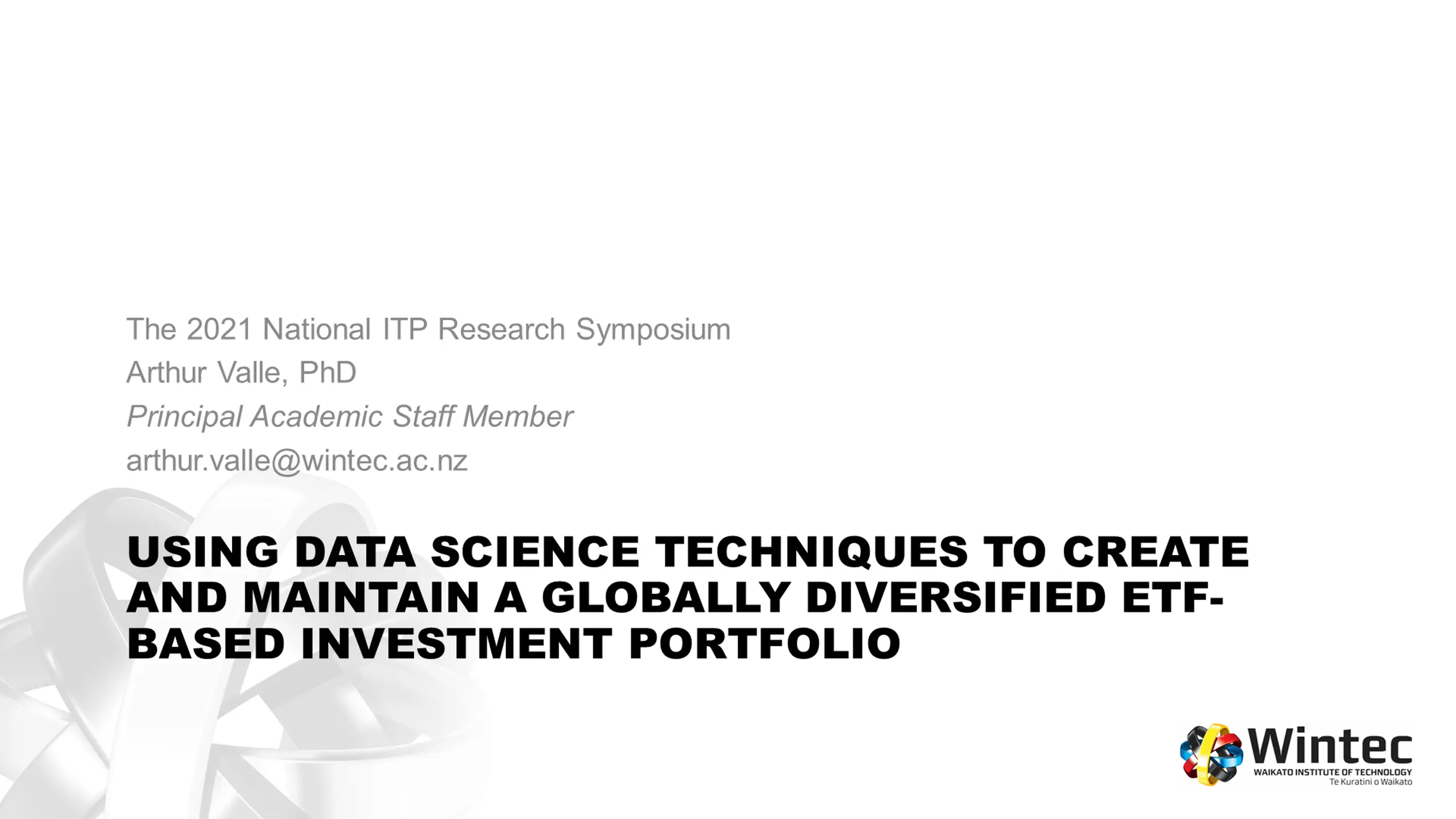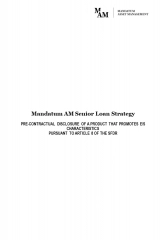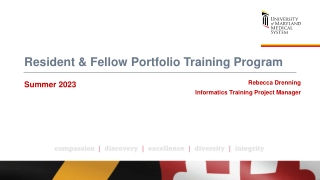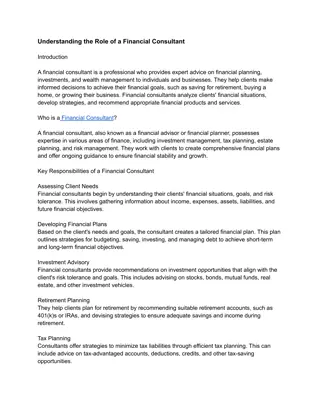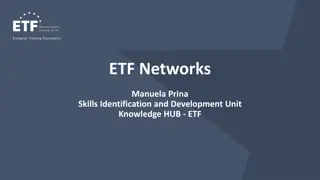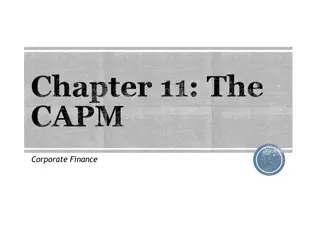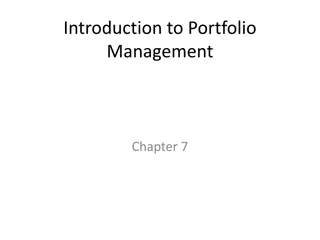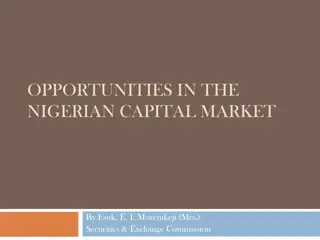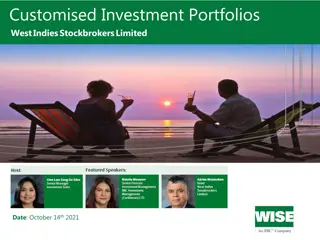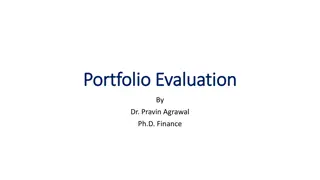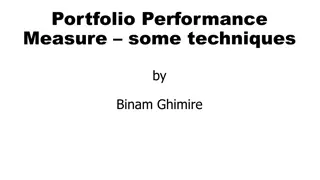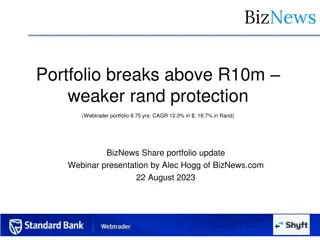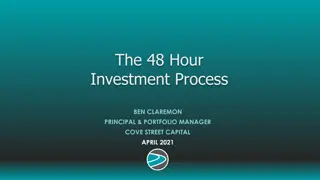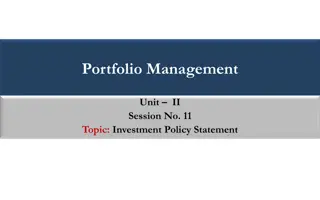Using Data Science Techniques to Create and Maintain a Globally Diversified ETF-Based Investment Portfolio
Implement a passive investment strategy using data science techniques to create and manage a globally diversified ETF-based portfolio. Discover the benefits of passive investing, key terminology, and steps to implement the strategy effectively.
Download Presentation

Please find below an Image/Link to download the presentation.
The content on the website is provided AS IS for your information and personal use only. It may not be sold, licensed, or shared on other websites without obtaining consent from the author.If you encounter any issues during the download, it is possible that the publisher has removed the file from their server.
You are allowed to download the files provided on this website for personal or commercial use, subject to the condition that they are used lawfully. All files are the property of their respective owners.
The content on the website is provided AS IS for your information and personal use only. It may not be sold, licensed, or shared on other websites without obtaining consent from the author.
E N D
Presentation Transcript
The 2021 National ITP Research Symposium Arthur Valle, PhD Principal Academic Staff Member arthur.valle@wintec.ac.nz USING DATA SCIENCE TECHNIQUES TO CREATE USING DATA SCIENCE TECHNIQUES TO CREATE AND MAINTAIN A GLOBALLY DIVERSIFIED ETF AND MAINTAIN A GLOBALLY DIVERSIFIED ETF- - BASED INVESTMENT PORTFOLIO BASED INVESTMENT PORTFOLIO
Introduction Content Arthur Valle, PhD Why invest? Why passive investing? Key terminology Example of a passive portfolio 3 steps to implement the passive strategy Data Science tools & techniques Conclusion PhD in Production and System Engineering: Process Mining Six Sigma Black Belt 23+ years of experience in IT Management: Lean Six Sigma, CMMI, ITIL, PMBOK, Agile/Scrum, etc DIY Investor (since 2016) Currently teaching and researching at Wintec-Waikato Institute of Technology, NZ Founder of TRENDSET (www.trendsetconsulting.com/en) Disclaimer: I am not an authorised financial advisor. This is not an investment recommendation. Past performance does not guarantee future return.
WHY INVEST? "YOU, OWNER OF PROFITABLE COMPANIES ALL OVER THE WORLD" "FREE TIME IN THE FUTURE For a decent retirement, you need to put your money to work for you and wait the time act on it. You won't get rich working for others - or even for yourself - from 9 am to 6 pm every day.
WHY INVEST PASSIVELY? " DO NOT WASTE TIME TRYING TO FIND THE NEXT TESLA" : it s the time in the market and regular contributions that will buy you "free time in the future". Dedicate your hours for your current source of income but put your savings (and time) to work for you! "IF YOU CAN'T BEAT IT, JOIN IT" In the long run, very few investors are able to consistently "beat the market", with low risk. Source: https://www.spglobal.com/spdji/en/research-insights/spiva/
Terminology Passive Investment: An investment strategy, aiming to obtain the same average return as the stock market indexes, such as S&P 500 or NZX 50. Implemented via ETF/index funds: greater diversification (ie. less risky) than stock picking Less effort (and knowledge): it avoids unnecessary buys and sells tends to have returns similar to active investing, in the long run. ETFs (or index funds): Exchange Traded Fund is a financial asset traded on the stock exchange. It replicates the performance of a given index. Largely used in the passive strategy as they are naturally diversified with lower management fees. Examples of NZX s ETFs: Smartshares NZ Top 50 (FNZ) Smartshares Emerging Markets ETF (EMF) Smartshares S&P/ASX 200 ETF (AUS) Smartshares Global Equities ESG ETF (ESG)
EXAMPLE OF A SIMPLE PASSIVE PORTFOLIO, WITH JUST 4 ETFs: 43.25% in Developed Markets Equities Invest in companies from developed markets: US, Europe, Japan, etc 13.50% in Emerging Market Equities Invest in companies from Emerging Markets: China, Russia, Brazil, Mexico, etc 26.50% in New Zealand Equities Invest in New Zealand listed companies. 16.75% in Australian Equities Invest in Australian companies.
3 STEPS TO IMPLEMENT THE PASSIVE STRATEGY? Step 1: Objectives, profile and portfolio Define your investment goals (ex: 12% return per year) and build a portfolio with assets that have the capability to achieve the goals but that also fits your profile as an investor (conservative, moderate, aggressive, etc)
STEP1 DATA SCIENCE TOOLS & TECHNIQUES For checking (statistical) capability: Normality Test, Mean, Standard Deviation, Confidence Intervals, Hypothesis Testing, Control Charts, Sigma level For selecting assets classes and assets and composing the portfolio: (in addition to the ones above) DOE-Design of Experiments, ANOVA, Back testing, Correlation https://www.statskingdom.com/320ShapiroWilk.html
WHAT ARE EXAMPLES OF LONG-TERM FINANCIAL GOALS? Example 3: Passive income a target of 0.40% per month, similar to the returns of real estate rentals. Example 1: Preservation of capital for example, a return target of around 1.5% per year. Example 4: Monetizing capital an average return expectation from 8 to 12% per year. Example 2: Protection against inflation and/or devaluation of the currency a return target of 3 to 5% per year.
EXPECTED AND HISTORICAL RETURNS (AND RISKS) https://interactive.researchaffiliates.com/asset-allocation#!/
3 STEPS TO IMPLEMENT THE PASSIVE STRATEGY? Step 2: Stay invested Contribute periodically to your portfolio (and re-balance it whenever needed).
STEP2 DATA SCIENCE TOOLS & TECHNIQUES For Predictions: (in addition to the previously mentioned ones) Interval Plot, Regression, Time Series, MonteCarlo Simulation, Machine Learning https://www.statskingdom.com/confidence-interval-calculator.html
FUTURE-VALUE FORMULA With contributions: Without contributions: Source: https://www.trendsetconsulting.com/en
MonteCarlo Simulation https://www.winton.com/the-future https://app.honestmath.com/
3 STEPS TO IMPLEMENT THE PASSIVE STRATEGY? Step 3: Time and opportunities Do not panic about crises or negative news: take advantage of opportunities and market conditions/cycles. Let the time (ie. compound interest!) to act, protecting and monetizing your capital in the long run.
STEP3 DATA SCIENCE TOOLS & TECHNIQUES For recognizing opportunities: Hypothesis testing, Control Charts, RSI-Relative Strength Index https://www.statskingdom.com/outlier-calculator.html
Where is the market going to? Tool: https://graphite-note.com/
Conclusion Investing is a fascinating topic. Active (supp. by Industry) x Passive (supp. by Academia) Strategies is an interesting debate. Other disciplines, such as Data Science, can also be part of the investor s toolbox (not only Macro- economics, Accounting, Company Valuations).
Thank You! Arthur Valle, PhD Principal Academic Staff Member arthur.valle@wintec.ac.nz
